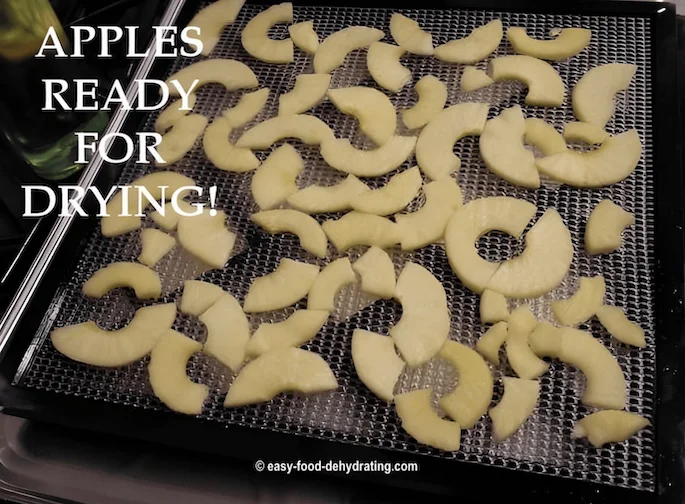How to Dehydrate Apples for Snacks,
Pies & Pantry Storage

Susan Gast | Author and blogger at Bored Boomers, Beesville Books, A New Sober You and Easy Food Dehydrating
Let's get busy learning how to dehydrate apples the "easy" way!

Why Dehydrate Apples at Home?
Create your own supply of dried apples at home so they'll be available to you all year round! How do you do that?
Dehydrate apples when they're on sale (and in season) and store them.
But first, here are a few FAQs:
Frequently Asked Questions
Best Apple Varieties for Dehydrating?
Best Apple Varieties for Dehydrating?
Apples with a higher water content - like Gala, Fuji, and Honeycrisp - they dehydrate well. Avoid mealy/mushy varieties unless you're going to be making apple sauce with them.
Can You Dehydrate Apples with the Skin On?
Can You Dehydrate Apples with the Skin On?
Leaving the skin on retains fiber and nutrients but it's certainly fine to peel them if you don't like, or want, a chewier texture
Can You Dehydrate Apple Peels?
Can You Dehydrate Apple Peels?
Yes! You can dehydrate apple peels and here are a few reasons why you should:
- Nutrients in the peel - Apple peel contains a lot of beneficial fiber and polyphenol antioxidants. Drying apple peels preserves these nutrients for use later.
- Natural pectin source - Dehydrated apple peels can be ground into a powder to use as a natural pectin replacement in jams, jellies, fillings, etc. The pectin comes from the peel.
- Tea or supplement ingredient - Dried apple peel powder can be used in herbal teas, capsules, and baked goods for extra nutrition.
- Food flavoring/garnish - Dehydrated apple peels lend a nice sweetness and pretty garnish to dishes like oatmeal, yogurt, and salads when rehydrated.
The key when drying apple peel is to thoroughly wash/clean the apples first and pat the peels dry before dehydrating. Monitor the peels closely for doneness so they don't over-dry or burn. It's a great use for what we might think of as apple "waste"!
What Temperature Should Apples Be Dehydrated At?
What Temperature Should Apples Be Dehydrated At?
125°F to 135°F is the usual drying temperature for apples, and basically all fruit.
How Long Does It Take To Dehydrate Apples?
How Long Does It Take To Dehydrate Apples?
It depends on how thick you slice them and on their water content. Having said that, between four and ten hours, all the way up to 15 hours.
How Can You Tell When The Apples Are Done?
How Can You Tell When The Apples Are Done?
Dehydrated apples will shrivel up a bit, be bendable, and will feel leathery.
How to Prepare Apples for Dehydrating
Simply follow the instructions coming up on how to dehydrate apples — and purchase apples when they are in season and plentiful via the grocery store in bags — or from your own backyard in bushels!
Apples Nutrition Info.
VITAMINS: Vitamin A, and Vitamin C, followed by Vitamin K with trace amounts of Choline, Pantothenic Acid, and Niacin.
MINERALS: Potassium, followed by Phosphorus, Calcium, Magnesium, and trace amounts of Zinc.
Apples also contain Omega-3 and Omega-6 fatty acids.

Help Prevent Oxidation by Doing This Simple Step
To prevent oxidation while dehydrating apples (that's what makes the apples turn brown—and bananas too)—spray the apples with good old lemon juice. I use the ReaLemon brand, but any "off-brand name" will work just as well!
Professional food dehydration plants use ascorbic acid to prevent/slow down oxidation.
TIP: When apples are out of season, use frozen apples instead. As noted below in the instructions for dehydrating apples, you won't have the peel the apples, plus you don't need to use apple juice to spray the apples in step 2 because the manufacturers did that step for us when they froze them. Now how easy is that?
How to Dehydrate Apples (Step-by-Step Infographic)
Here’s a visual overview of the simple steps—perfect for quick reference!

📌 Pin this for later!
Step-by-Step Instructions: How to Dehydrate Apples
If using frozen apples, ignore steps 1 and 2.
- Peel, core, and slice your apples by hand or with a handy apple-peeler-corer gadget.
- Place slices in a bowl and generously spray with lemon juice. TIP: Use a pump top from a new unused spray bottle, pick one that fits your lemon juice bottle, and look for one that has a long enough plastic tube that will reach the bottom of your lemon juice bottle.
- Arrange the apple slices on your dehydrator trays, making sure the apples don't overlap.
- Turn on your food dehydrator and set the temperature between 125°F and 135°F (or per your food dehydrator's instructions).
💡 Tip: Use our Fahrenheit to Celsius converter here on our site!
- Delicious dried apples are pliable when dried.
- Drying time: between 4-10 hours.
- Please remember to rotate your dehydrator trays for even drying.

How to Rehydrate Dried Apples
Simply add water to your dried apples to rehydrate them. Read more about re-hydrating food here and we're off making the best apple pies around!
How about applesauce, or apple breads, or cookies? Mmm :-) Soon the delicious apple pie aroma from your kitchen will draw friends and neighbors for miles!
Best Apple Peeler Corer Tool (peels potatoes too)!
You'll want one of those apple peeler corer gadgets that I'm using shown above.
Not only are they easy to use, they are truly fascinating to watch them do their job.
Take the grunt work out of spud peeling—yes, you can peel potatoes with them too!
As an Amazon Associate, I earn commission from qualifying purchases. The price you pay does not increase. Read disclosure here.

Different Kinds of Apples to Try
While there are many different types of apples, the most common type is the red delicious apple. Other popular types of apples include:
- Granny Smith
- Golden Delicious
- Rome
Each type of apple has its own unique flavor, so be sure to try a few different kinds to find your favorite.
When and Where to Grow Apples
The best areas to grow apples are in cool climates with well-drained soils. Apples need full sun and well-drained soil to thrive, so make sure you choose a spot that gets plenty of sunlight and has good drainage.
Additionally, apples are a cold-weather crop, so they do not do well in warm or damp conditions.
When is the Best Time to Pick Apples?
The best time to pick apples is in the fall after the leaves have turned color and before the first frost. Apples are typically ripe and ready to pick in September or October, depending on the variety.
Thanks for reading about how to dehydrate apples, visit this page for all our listed fruits!
Get Your Free Guide to Dehydrating Like a Pro!
Don't forget to grab your free Six Simple Steps eBook! It’s packed with tips for dehydrating everything from fruits and veggies to dog treats. Get it here.
Before You Go...
If you like the content, please give me some love by clicking on the 🩷 in the lower right hand corner (on just about all my pages). This signals to me that you find it enjoyable and useful. Thank you so much!


















